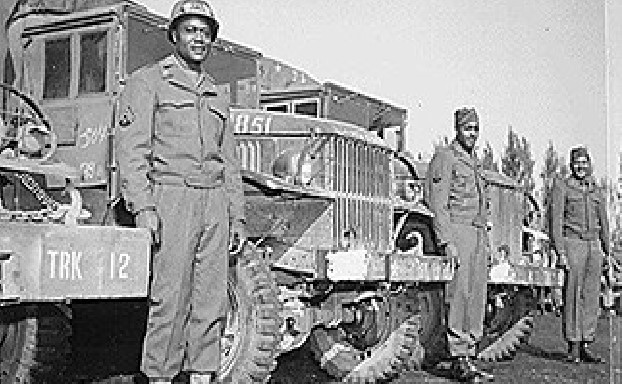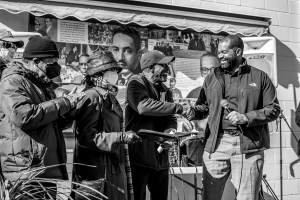By Col. (Ret.) Edna W. Cummings, U.S. Army
Special to the AFRO
“All last night, guns shook on the ground on which I slept. Our long toms slugged it out with
German 88s in a duel that has no end.” — Ollie Stewart, Afro American Newspaper, correspondent with Invasion Forces, France, July 15, 1944.
Eighty years ago, the most heralded battle of World War II, June 6, 1944, or D-Day, consisted of Allied Forces landing along the 50 mile stretch of beaches along the coast of Normandy, France.
The beaches held code names of Utah, Omaha, Gold, June and Sword.
Approximately 2,000 Black troops participated in Operation Overlord and the full Battle of Normandy that lasted until August 1944. Relegated to service units, they moved supplies (e.g., Red Ball Express), built bridges, and dug graves for the fallen.
Of the 9,387 military personnel laid to rest at Normandy American Cemetery in Colleville-sur-Mer, France, 135 are African-Americans men, three are women, and five are listed on the Wall of the Missing.
Only one Black combat unit, the 621 member 320th Barrage Balloon Battalion, landed on D-Day at Omaha and Utah Beaches. Three soldiers from that unit died on June 6, Cpls. Brooks Stith from North Carolina, Henry Harris originally from Pennsylvania, and Private James L. Simmons, of Upper Marlboro, Maryland. Brooks and Stith are buried at Normandy and Simmons is buried at Mt. Carmel Cemetery, Upper Marlboro.
A July 1944 Afro American Newspaper reported on the death of Simmons, who arrived in France in December 1943. Three days before he died, he wrote to his family, “The way things are going now, it won’t be long before I’ll be going home.”
At 22 years old, Sgt. Willie Leroy Collins from Macon, Georgia, also died on June 6, 1944. He served with the 490th Port Battalion. He was killed by German artillery while unloading cargo onto Utah Beach. He was the only reported D-Day casualty from his unit.
Beyond D-Day
Planning for the catalytic D-Day battle began several years prior, and in December 1943 the engagement strategy developed into Operation Overlord that lasted until June 30, 1944. However, the full Battle of Normandy did not end until August 1944 with the liberation of Paris.
The war in the European Theater of Operations ended with Germany’s surrender on May 8, 1945. According to the Department of Defense, between June 1944 and May 8, 1945, there were 552,117 U.S. casualties in the European Theater of Operations with 104,812 killed in action. Some of these deaths occurred in segregated units that constructed and repaired roads, airfields and bridges.
The 364th Engineer Service Regiment has five members buried at Normandy who died from July-August 1944: PFC Earlie Carothers, 25, of Mississippi, July 7; Sgt. Melvin Jones, 22, of Georgia, July 8; PFC William L. Ryerson, 24, of New York, July 7; Cpl. General U. Walker, 25, of Florida, July 7; and Master Sgt. James W. Kersh, of Tennessee, Aug. 11.
The only Black officer buried at Normandy is Second Lt. Eddie May. He was originally from Mississippi and joined the Army in Wisconsin and served with the 1349th General Service Regiment. In 1942 he graduated from Beloit College and Beloit refers to him as one of the finest athletes in World War II. In 1964 Beloit inducted him into the Hall of Honor.
Also buried at Normandy is one Black Merchant Marine, Mess Steward Earlie J. Gabriel, and several Navy personnel. Two days after D-Day, Clarence N. Copeland was killed. He was a Navy Steward’s Mate Second Class from Jersey City, Hudson County, New Jersey. Copeland was assigned to the USS Rich that sank from hitting an underwater mine and a follow-on attack by the Germans.
In July, 1945, three Black women from the 6888th Central Postal Directory Battalion lost their lives in a vehicular accident, Sgt. Delores Brown and Private Mary Barlow, of Connecticut, and Private Mary Bankston, New York. Barlow and Bankston were members of the 6888th’s entertainment troupe that performed two months earlier at a show hosted by the Birmingham, England Hospitality Committee. Unlike other troops buried at Normandy under combat conditions (i.e., mattress covers, parachutes, tentage, or similar materials), these women were buried in their military service dress uniforms. The 6888th’s commander, Maj. Charity Adams collected funds to ensure burial in a casket built by German prisoners. Like other wartime interments, initially, the women were buried at another location, and with their families’ consent, relocated to Normandy American Cemetery in 1948.
On March 14, 2022, President Biden recognized the 6888th’s service with the nation’s highest honor, a Congressional Gold Medal.
Normandy’s Wall of the Missing bears 1,557 names, and three are from the segregated 364th Engineer Service Regiment who died on July 7, 1944: PFC Sylvester D. Haggins, New York; PFC Mack Homer, Georgia; and Tech 5 Daniel Wyatt, Louisiana. Two other names of Black troops appear on the wall: Tech 5 Reese G. Boone from North Carolina, 514th Port Battalion and TSGT Raymond Heads, Texas of the 3688th Quartermaster Truck Company.
As we honor the fallen on Memorial Day and commemorate the 80th Anniversary of D-day, I hope that we continue to honor the service and sacrifice of the thousands of troops who are missing or resting in hallowed grounds away from their loved ones.
The post Commentary: Honoring the Black, buried, and missing at Normandy American Cemetery appeared first on AFRO American Newspapers.











